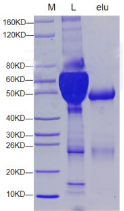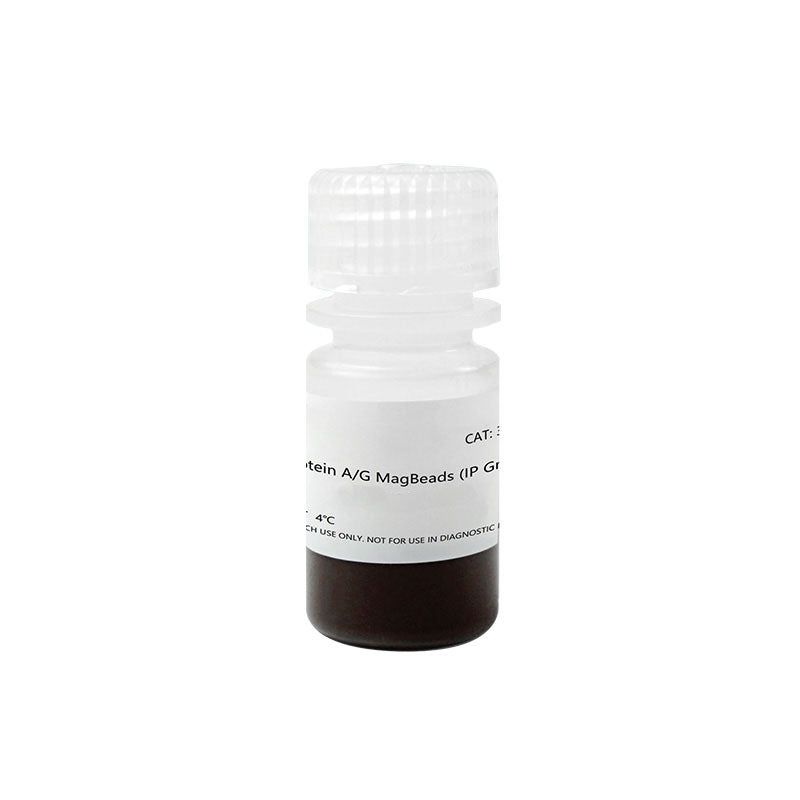Description
Protein A/G MagBeads use "nano-surface biotechnology" (S-TEC) to target Protein A/G onto the surface of superparamagnetic polymer microspheres with high density. It has higher antibody binding ability and very low non-specific adsorption rate of protein. One-step purification can isolate the antibody with purity >90% from the serum sample, which is simple and effective to use. Natural Protein A is a cell wall surface protein found in Staphylococcus aureus. Natural Protein G is a cell surface protein isolated from the genus G or C Streptococcus. Both have similar functions and bind most mammalian IgG by interacting primarily with the Fc region of immunoglobulin (Ig), but differ in their binding specificity. Protein A/G MagBeads covalently conjugate both protein A and protein G, providing A wider binding range and higher utility than either protein A or protein G alone. At the same time, this product uses genetically modified proteins A and G, which not only maintain their Ig affinity properties, but also remove the non-major binding domain of the natural protein itself to reduce non-specific binding. This product has a wide range of application, can be used in cell lysis fluid, cell secretory fluid supernatant, serum, animal ascites and other immune antigen samples.
Features
- Low background—little to no nonspecific binding, and no preclearing
- Highly reproducible—uniform beads ensure the most consistent results
- Highly sensitive—Magbeads technology is the most cited method for sensitive applications, such as ChIP and IP, of low abundance proteins
- Fast and easy— no centrifugation or preclearing steps
- Versatile—products for IP, Co-IP, pull-down, and ChIP assays.
Applications
- Immunoprecipitation (IP)
- Purification of antibody
Specifications
| Ligand | rProtein A/G |
| Binding Capacity | ≥50 μg hIgG /mg |
| Particle size | 1 μm |
| Concentration | 10 mg/mL |
| Storage Buffer | PBS, 0.01% Tween-20, 0.02% NaN3 |
Smaller beads, Higher capacity
|
Thermo Dynabeads™ Protein G/Protein A, 10003D/10001D |
Yeasen Protein A/G MagBeads, 36417ES |
|
|
Diameter |
2.8 μm |
1 μm |
|
Concentration |
30 mg/mL |
10 mg/mL |
|
Capacity |
About 8 µg human IgG/mg beads |
About 50µg human IgG /mg beads |
Components
| Components No. | Name | 36417ES03 | 36417ES08 |
| 36417 | rProtein A/G MagBeads (IP Grade) | 1 mL | 5 mL |
Storage
The products should be stably stored at 2~8℃ for 2 year.
Figures

Figure 1. The SDS-PAGE gel electrophoresis results of Rabbit serum purification by Protein A/G MagBeads (IP Grade).
L: sample
L: eluate


36417_Manual_HB230112_EN.pdf
Citations & References:
[1] Zhou L, Zhuang H-J, Chen Q, Jiang L-P, Han X-M, Ge Y-X, et al. Precise targeting of osteopontin in non-small cell lung cancer spinal metastasis to promote chemosensitivity via a smart hollow nano-platform. Chemical Engineering Journal. 2022;436:132131.(IF:15.1)
[2] Jiang Y, Guo H, Tong T, et al. lncRNA lnc-POP1-1 upregulated by VN1R5 promotes cisplatin resistance in head and neck squamous cell carcinoma through interaction with MCM5. Mol Ther. 2022;30(1):448-467. (IF:11.454)
[3] Wang Y, Gao W-Y, Wang L-L, Wang R-L, Yang Z-X, Luo F-Q, et al. FBXW24 controls female meiotic prophase progression by regulating SYCP3 ubiquitination. Clinical and Translational Medicine. 2022;12(7):e891.(IF:10.6)
[4] Wang Y, Gao WY, Wang LL, et al. FBXW24 controls female meiotic prophase progression by regulating SYCP3 ubiquitination. Clin Transl Med. 2022;12(7):e891. doi:10.1002/ctm2.891(IF:8.554)
[5] Cen Y, Zou X, Zhong Q, et al. The TIAR-mediated Nrf2 response to oxidative stress is mediated through the Nrf2 noncoding 3'untranslated region in Spodoptera litura. Free Radic Biol Med. 2022;184:17-29. doi:10.1016/j.freeradbiomed.2022.03.016(IF:7.376)
[6] Hua Z, Wei R, Guo M, Lin Z, Yu X, Li X, et al. YTHDF2 promotes multiple myeloma cell proliferation via STAT5A/MAP2K2/p-ERK axis. Oncogene. 2022;41(10):1482-91.(IF:8.0)
[7] Zhou W, He P, Liu H, Wei H, Yu J. A luciferase based automated assay for rapid and sensitive detection of SARS-CoV-2 antibodies. Analytica Chimica Acta. 2023;1238:340633.(IF:6.2)
[8] Zhenzhen L, Wenting L, Jianmin Z, et al. miR-146a-5p/TXNIP axis attenuates intestinal ischemia-reperfusion injury by inhibiting autophagy via the PRKAA/mTOR signaling pathway. Biochem Pharmacol. 2022;197:114839. doi:10.1016/j.bcp.2021.114839(IF:5.858)
[9] Wang L, Yi J, Yin XY, et al. Vacuolating Cytotoxin A Triggers Mitophagy in Helicobacter pylori-Infected Human Gastric Epithelium Cells. Front Oncol. 2022;12:881829. Published 2022 Jul 14. doi:10.3389/fonc.2022.881829(IF:5.738)
[10] Meng J, Zhang C, Wang D, Zhu L, Wang L. Mitochondrial GCN5L1 regulates cytosolic redox state and hepatic gluconeogenesis via glycerol phosphate shuttle GPD2 [published online ahead of print, 2022 Jun 28]. Biochem Biophys Res Commun. 2022;621:1-7. doi:10.1016/j.bbrc.2022.06.092(IF:3.575)
[11] Chen P, Wang L, Long YB, et al. E2F4 regulates the cell cycle and DNA replication in the silkworm, Bombyx mori. Insect Sci. 2022;29(4):1006-1016. doi:10.1111/1744-7917.12991(IF:3.262)

